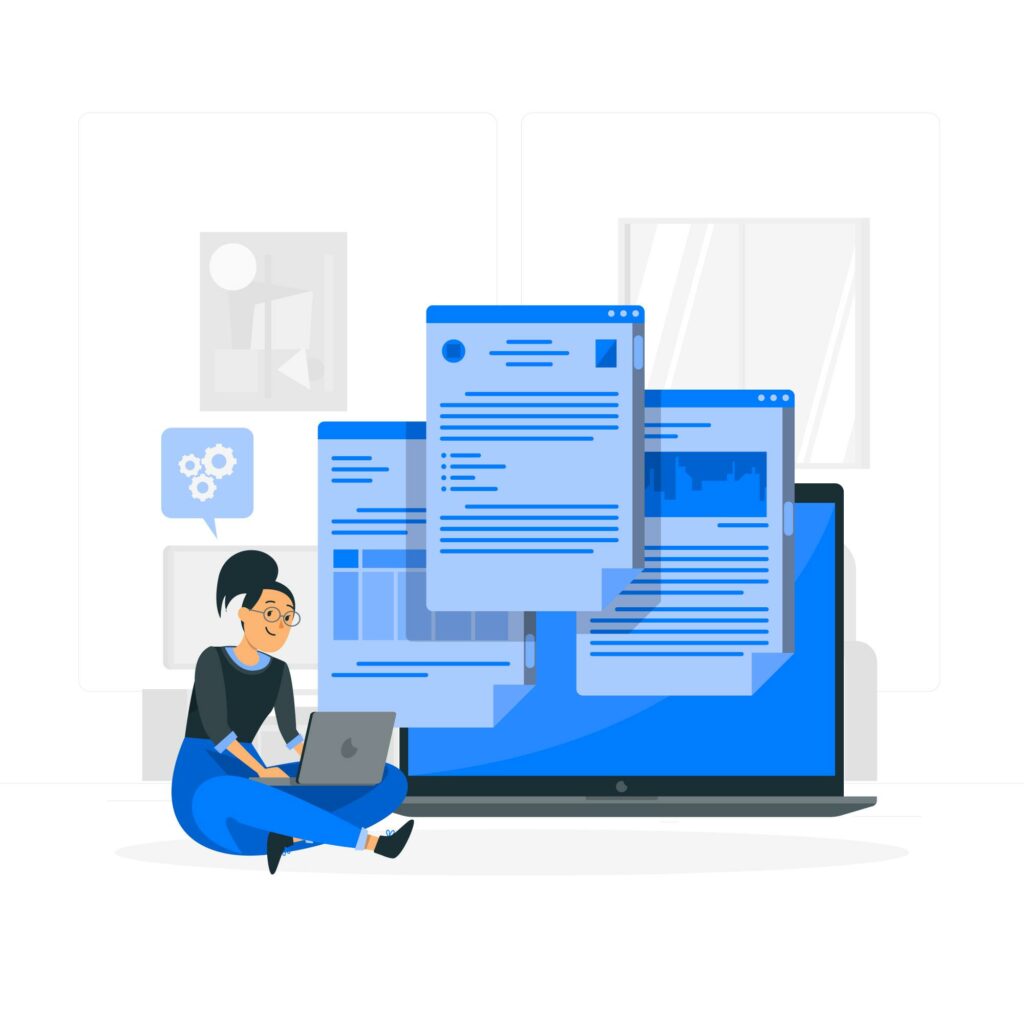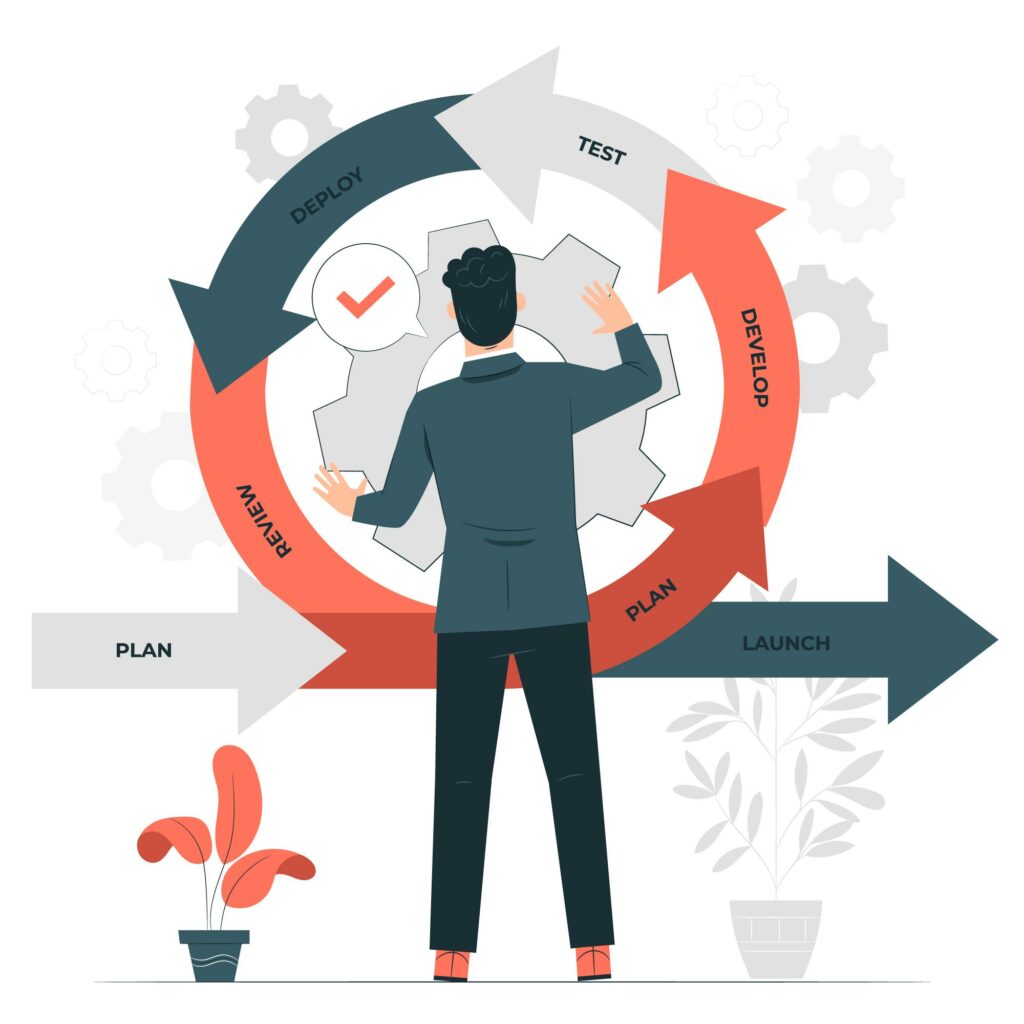Agile software development is a widely adopted methodology that has revolutionized the way software is developed. This article provides an overview of what Agile software development is, its key principles and values, the benefits it offers, and the Agile software development cycle.
What is Agile Software Development?
Agile represents a software development approach that prioritizes flexibility and introduces a practical approach to delivering the final product. Embracing Agile often necessitates a cultural transformation within organizations as it emphasizes the incremental delivery of software components rather than the complete application.

The advantages of Agile encompass assisting teams in a dynamic environment while concentrating on the effective delivery of business benefits. The cooperative atmosphere promoted by Agile enhances organizational efficiency as teams collaborate and comprehend their distinct roles within the framework.
Additionally, businesses that employ Agile can launch a top-notch product because of continuous testing throughout the development phase. This allows for timely adjustments and early detection of potential issues.
While Agile has largely supplanted waterfall as the predominant development approach in many firms, it faces the challenge of potentially being overshadowed or integrated into the rising prominence of DevOps.
The four values of Agile
In 2001, a group of 17 software experts came together to create the Agile Manifesto. This document outlined four key principles that form the foundation of Agile methodology. Although there are ongoing debates about its importance, the Agile Manifesto remains a core tenet of the Agile movement.
The Agile Manifesto has the following four key principles:
1. Prioritizing individual interactions over processes and tools
The most important part of development is the people who drive the process and meet the business needs. People are the key element in development and should be valued over processes and tools.
When processes or tools dictate the development path, the team may find it difficult to adjust to changes, which could lead to not meeting customer expectations.
2. Emphasizing working software over comprehensive documentation
In the past, a lot of time was spent on creating documents for products during their development, which caused delays. However, Agile methodology doesn’t completely ignore documentation but instead focuses on providing developers with crucial information like user stories.

This helps them complete their tasks efficiently. The Agile Manifesto recognizes the significance of documentation, but it prioritizes functional software over documentation.
3. Advocating collaboration over contract negotiations
Agile encourages teamwork between the customer and project manager rather than just relying on negotiations. By including the customer throughout the development process, instead of just at the start or end, it helps the team align better with the customer’s needs.
This approach allows for the customer to see periodic product demonstrations and actively participate in meetings, ensuring that the product meets their expectations.
4. Prioritizing adaptability to change
In the past, software development was resistant to change because it was seen as a costly burden. However, Agile methodology challenges this notion.
Its iterative process makes it easy to incorporate changes, allowing teams to customize the process to their benefit. Essentially, Agile sees change as an opportunity to improve the project and provide more value.
The 12 Agile Principles
The Agile Manifesto describes 12 foundational principles for the development process, which include:
- Prioritize customer satisfaction through early and continuous delivery of valuable outputs.
- Divide significant tasks into smaller, manageable units for swift completion.
- Acknowledge that optimal outcomes arise from self-organizing teams.
- Furnish motivated individuals with a conducive environment and necessary support, entrusting them to accomplish their tasks.
- Formulate procedures that foster sustainable work efforts.
- Maintain a consistent speed in completing tasks.
- Embrace modifications to requirements, even when introduced late in the project.
- Facilitate daily interactions between the project team and business stakeholders throughout the project duration.
- Encourage the team to periodically reflect on enhancing effectiveness, and subsequently adjust their actions.
- Gauge progress based on the volume of completed tasks.
- Persistently strive for excellence.
- Leverage changes as a means to gain a competitive edge.
The Agile Software Development Process

Agile software development process comprises six distinct stages:
- Concept
- Inception
- Iteration/Construction
- Release
- Production
- Retirement
First Step – Concept
The initial stage, concept, means identifying potential business opportunities for each project and estimating the required time and effort for project completion.
This data allows to prioritising projects, determining which ones are technically and economically viable for pursuit.
Second Step – Inception
In the second step called inception, the team is formed, money is secured, and the initial needs are discussed with the client. It’s important to create a timeline to show what each team member should do and when they should do it. A sprint is a period of time when certain tasks have to be finished and then reviewed.
Third Step – Iteration/Construction
During the iteration/construction phase, teams start building functional software based on requirements and feedback. The Agile approach uses iterative cycles that build upon each other until the project is complete.
Each iteration lasts between two to four weeks and has a predetermined completion date. The goal is to have a deployable product by the end of each iteration.
There are multiple iterations in the development process, each with its distinct workflow. A standard iteration includes:
- – Defining requirements using the product backlog, sprint backlog, and feedback from customers and stakeholders.
- Developing software based on the established requirements.
- Performing QA testing, training (both internal and external), and documentation.
- Deploying and integrating the functional product into production.
- Obtaining feedback from customers and stakeholders to determine new requirements for the ensuing sprint.
Fourth Step – Release
During the release phase, it is time to do the last checking to make sure everything works properly, fix any remaining problems, and create the final documents. This all leads up to putting the final version into use.
Fifth Step – Production
After the software is released, the focus shifts to providing continuous support to maintain it. The development team is responsible for making sure that the software runs smoothly and also for teaching users how to use it.
This phase continues until support for the software ends or a plan is made to retire the product.
Sixth Step – Retirement
When a system becomes outdated, unnecessary, or doesn’t align with the business plan, organizations need to replace it. This phase is referred to as the retirement phase.
During this phase, customers are notified and any remaining data is moved to another system. Finally, the old system is taken out of use.
In Agile methodology, the product backlog can be updated with new features as needed. However, the process involves going through each stage repeatedly until all items in the backlog are completed. This makes the Agile cycle more of a cycle than a linear process.
At the same time, an organization may work on multiple projects, each with its own stages covering different product lines, meeting the needs of both internal and external clients.
Types of Agile methodologies
Every Agile Agile software development methodology aims to adapt to changes efficiently while delivering functional software.
However, the manner in which these methodologies outline the software development process differs. Some of the most popular Agile methodologies are:
- Scrum
- Lean software development
- Extreme programming
- Crystal
- Kanban
- Dynamic systems development method
- Feature-driven development
Scrum
Scrum is an Agile framework that is suitable for project managers who oversee iterative and incremental projects. In Scrum, the product owner works with their team to identify and prioritize system functionalities and creates a product backlog.
This backlog is a list of all tasks required to produce a functional software system, including bug fixes, features, and non-functional requirements.
Once the product backlog is established, it cannot be changed, and only the designated team can add additional functionalities.
After deciding what’s important with the team and product owner, cross-functional teams promise to create working software every 30 days. This is called a sprint. After each sprint, the team looks at their list of things to do, or backlog, and decides what’s most important to work on next.
They do this by looking at what they’ve accomplished so far and what they still need to do. Scrum is a popular way of working because it’s simple, it helps teams get things done, and it combines ideas from other ways of working.
Lean software development
Lean software development is an additional iterative approach that emphasizes the use of efficient value stream mapping to guarantee the delivery of value to customers. It is adaptable and progressive, lacking strict guidelines or regulations. The Lean approach is grounded in the following core principles:
- Enhancing learning
- Empowering teams
- Promoting integrity
- Eliminating waste
- Grasping the entire process
- Deferring decisions until necessary
- Speeding up product delivery
The Lean approach hinges on prompt and dependable feedback between customers and developers to facilitate swift and effective development processes.
To achieve this, it delegates decision-making authority to individuals and small teams rather than adhering to a hierarchical control structure. In a bid to minimize waste, Lean encourages users to prioritize and select genuinely valuable features for their system, delivering them in incremental batches.
Additionally, Lean software development advocates for the concurrent creation of automated unit tests alongside coding and strives to maximize the productivity of every team member.
Extreme programming (XP)
Extreme Programming (XP) is a structured approach that emphasizes speedy and continual delivery of software. It focuses on engaging customers, getting quick feedback, planning and testing continuously, and encouraging teamwork.
The team releases software at regular intervals, usually every one to three weeks. The main goal is to improve software quality and adaptability in response to customer needs.
XP is based on the principles of communication, feedback, simplicity, and courage. Customers work closely with the development team to explain and prioritize their desired user stories. It is up to the team to produce tested, functional software that corresponds to the most important user stories in each iteration.
XP offers a flexible and simple framework that helps users deliver high-quality software efficiently.
Crystal
Crystal stands out as the most flexible and lightweight Agile Agile software development methodology, placing a strong emphasis on interpersonal interactions within an Agile project, as well as the business-critical nature and priority of the ongoing system development.
Recognizing that each project possesses distinct attributes necessitating a tailored approach, Crystal comprises a variety of Agile process models, such as Crystal Orange, Crystal Clear, and Crystal Yellow.
Each model is characterized by unique features influenced by factors like project priorities, team size, and system importance.
In line with other Agile approaches, Crystal prioritizes regular delivery of functional software, active customer participation, flexibility, and the reduction of unnecessary bureaucracy and distractions. Its foundational principles revolve around communication, teamwork, and simplicity.
Kanban
Kanban uses a visual workflow management technique that enables teams to actively oversee product development, with a focus on continuous delivery, without adding undue stress to the software development lifecycle (SDLC). It has gained traction among teams practicing Lean software development as well.
The Kanban approach is grounded in three fundamental principles: visualizing the workflow, restricting the work in progress, and enhancing the flow of work.
Similar to Scrum, Kanban is crafted to enhance team efficiency and foster seamless collaboration.
It promotes continuous engagement and strives to establish an optimal workflow, cultivating an environment conducive to continuous learning and improvement.
Dynamic Systems Development Method (DSDM)
The Dynamic Systems Development Method (DSDM) was created to provide a standardized framework for delivering software quickly.
It follows eight foundational principles that are essential for successfully completing a project. These principles cover the entire project lifecycle and include:
- Collaboration
- Timely delivery
- Demonstrable control
- Consistent and transparent communication
- Unwavering focus on business requirements
- Iterative development
- Incremental creation grounded on solid foundations
- Uncompromising commitment to quality
Within the DSDM framework, the process incorporates rework, ensuring that all modifications remain reversible. To prioritize system requirements, DSDM employs the MoSCoW Rules, categorizing priorities as:
- M (Must have)
- S (Should have)
- C (Could have, but not essential)
- W (Won’t have now, but potential for later)
In DSDM, it’s important to recognize that not all requirements hold equal significance. Each iteration should include less critical elements, allowing high-priority requirements to remain unaffected.
Feature-Driven Development (FDD)
Feature-Driven Development (FDD) combines various best practices in software development. It breaks down work into features, assigns specific responsibility to one person for parts of the code, and creates models that represent the problem being solved.
FDD starts by creating an overall structure, which helps to identify all the features that need to be built.
Then, the team works in two-week cycles, focusing on planning, designing, and building individual features. If a feature takes longer than two weeks to develop, it’s usually a good idea to break it down into smaller pieces.
One of the advantages of FDD is that it can work well for large teams, thanks to its “just enough design initially” (JEDI) approach.
Advantages and Disadvantages of Agile
Over the years, comparisons have often been drawn between Agile and Waterfall methodologies. During the Waterfall phase of software development, developers operated independently, with minimal to no collaboration, before passing the software to testers and subsequently to production.
Poor management or late addressing of issues like bugs, complexities, and feature changes led to significant project delays or even project cancellations.
In contrast, the Agile approach, where everyone, including business stakeholders, remained actively engaged and informed throughout the development process, marked a significant shift in organizational culture and accelerated the delivery of superior software to the market.
Under Agile, the significance of collaboration and communication became tantamount to technological prowess. Given the flexibility of the Agile Manifesto, organizations of various sizes and sectors have tailored and adapted Agile to suit their needs. This cultural shift towards Agile also paved the way for the emergence of DevOps in software development.
Some argue that numerous organizations alter or dilute Agile, making it susceptible to change. This prevalent trend often leads people who practice Agile with modifications to be referred to as “ScrumButs,” indicating deviations from pure Agile practices.
While Agile fosters communication between developers and business stakeholders, it has been less effective in integrating testing and operations, potentially hindering the broader adoption of DevOps.
Another criticism of Agile pertains to its perceived neglect of technological aspects, making it challenging to convey its value to senior managers unfamiliar with the role of organizational culture in software development.
Additionally, the pressure to complete sprints punctually can create a high-stress environment for developers, often leading to extended working hours and tight deadlines.
[Want to learn more on custom software development? Click here to reach us.]
Conclusion
Agile software development has changed the way software projects are approached by emphasizing flexibility, collaboration, and adaptability. It enables rapid delivery of high-quality software that meets customer needs effectively by fostering close teamwork and continuous feedback.
Although Agile offers many benefits such as better communication and adaptability, it also presents challenges like potential deviations from core principles and the integration of testing and operations.
Despite these challenges, Agile’s versatility and responsiveness to change make it a compelling choice for modern software development. As the industry continues to evolve, Agile is poised to remain a dominant methodology, driving innovation and efficiency.
By embracing Agile principles and adapting its practices, and with the help of an advanced team such as Bobcares, organizations can thrive in today’s dynamic digital landscape.
PREVENT YOUR SERVER FROM CRASHING!
Never again lose customers to poor server speed! Let us help you.
Our server experts will monitor & maintain your server 24/7 so that it remains lightning fast and secure.







0 Comments